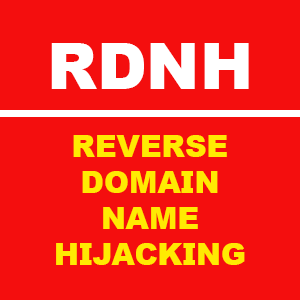
RDNH finding.
The domain infocert.com was registered in 1998, making it 21 years old.
Infocert S.p.a., Italy, attempted to wrestle the domain away from its registrant.
The Respondent says it has owned and used the Disputed Domain Name since its registration date of October 1, 1998. It says it is in precisely the same area of business as the Respondent. It says the term “infocert” is formed by the conjoining of two contractions of words directly applicable to that line of business, namely “information” and “certificate”.
The earliest trademark cited by the Complainant has a registration date of May 2010.
The WIPO panelist denied the domain’s transfer, and slapped the Complainant with a finding of Reverse Domain Name Hijacking (RDNH) on the following basis:
(1) the Complaint could never have succeeded given the Disputed Domain Name was registered before the Complainant even existed.
(2) The Complainant’s case that “infocert” was a coined word and could only relate to itself was obviously wrong and seems to have simply ignored the obvious conjoining of abbreviations for “information” and “certificate”. Apart from anything else, the fact that the Disputed Domain Name was registered before the Complainant even existed should have alerted the Complainant to the fact that its case on this issue could not be correct.
(3) The Complaint was wrong to assert the Disputed Domain Name was not in use. The Panel accepts this was not an intentional misleading but arose because of how the Respondent’s systems operate (see above). More detailed investigation by the Complainant could however have shown its case was incorrect.
(4) The Complainant also failed to explain that it attempted to buy the Disputed Domain Name and appears to have tried to use the filing of the Complaint as a bargaining lever in that process.
Full details on the decision for infocert.com follow:
Copyright © 2025 DomainGang.com · All Rights Reserved.Infocert S.p.a. v. Information Brokers, Inc.
Case No. D2019-14051. The Parties
The Complainant is Infocert S.p.a., Italy, represented by Studio Torta S.p.A., Italy.
The Respondent is Information Brokers, Inc., United States of America (“United States”), represented by Greenberg & Lieberman, United States.
2. The Domain Name and RegistrarThe disputed domain name <infocert.com> (the “Disputed Domain Name”) is registered with Network Solutions, LLC (the “Registrar”).
3. Procedural History
The Complaint was filed with the WIPO Arbitration and Mediation Center (the “Center”) on June 18, 2019. On June 19, 2019, the Center transmitted by email to the Registrar a request for registrar verification in connection with the Disputed Domain Name. On June 19, 2019, the Registrar transmitted by email to the Center its verification response confirming that the Respondent is listed as the registrant and providing the contact details.
The Center verified that the Complaint satisfied the formal requirements of the Uniform Domain Name Dispute Resolution Policy (the “Policy” or “UDRP”), the Rules for Uniform Domain Name Dispute Resolution Policy (the “Rules”), and the WIPO Supplemental Rules for Uniform Domain Name Dispute Resolution Policy (the “Supplemental Rules”).
In accordance with the Rules, paragraphs 2 and 4, the Center formally notified the Respondent of the Complaint, and the proceedings commenced on June 20, 2019. In accordance with the Rules, paragraph 5, the due date for Response was July 10, 2019. On July 4, 2019, the Respondent requested an extension under paragraph 5(e) of the Rules. Accordingly, the Response due date was extended to July 20, 2019. The Response was filed with the Center on July 18, 2019.
The Center appointed Nick J. Gardner as the sole panelist in this matter on July 23, 2019. The Panel finds that it was properly constituted. The Panel has submitted the Statement of Acceptance and Declaration of Impartiality and Independence, as required by the Center to ensure compliance with the Rules, paragraph 7.
4. Factual Background
The Complainant is an Italian company providing electronic certification services. It describes itself as “the market leader in digitization and dematerialization services as well as one of the main Certification Authorities at European level for the services of Certified Electronic Mail, Digital Signature and Digital Document Preservation”. It manages 6.5 million digital signature certificates, and has 52,000 electronic billing service customers, and 750 million digitally stored documents. It had a turnover of EUR 62.3 million turnover in 2018. It has been in business since July 2004. It has various trademark registrations for the term “infocert” the earliest of which is Italian registration number 1293727 which was registered on May 28, 2010, and which is for a stylised form of the word. These trademarks are referred to in this decision as the “INFOCERT trademark”.
The Disputed Domain Name was registered on October 1, 1998.
The Respondent and its business and the manner in which the Disputed Domain Name is used are discussed below.
5. Parties’ Contentions
A. Complainant
The Complainant says that the Disputed Domain Name is identical to the Complainant’s INFOCERT Trademark.
It says the Respondent has no rights or legitimate interests in respect of the Disputed Domain Name and/or in the term “infocert”, as it is not the Respondent’s name.
It says that the registration and use of the Disputed Domain Name is in bad faith. It says that the Disputed Domain Name does not resolve to an active website. It says “infocert” is a coined word with no other meaning and can only relate to the Complainant. It relies upon the well-known decision in Telstra Corp. v. Nuclear Marshmallows, D2000-0003, and the principles set out in that decision. It also relies upon many subsequent decisions to similar effect. It says the Respondent has been retaining the Disputed Domain Name for many years without having attempted to develop any business and such fact proves beyond any reasonable doubt the bad faith and the intention to block the registration of the Disputed Domain Name by the Complainant.
B. RespondentThe Respondent has filed a lengthy and detailed response, accompanied by a declaration from its founder and CEO. The main points the Respondent makes are very straightforward and can be summarised as follows.
The Respondent says it has owned and used the Disputed Domain Name since its registration date of October 1, 1998. It says it is in precisely the same area of business as the Respondent. It says the term “infocert” is formed by the conjoining of two contractions of words directly applicable to that line of business, namely “information” and “certificate”. It says that “Info Cert” or “InfoCert” or “Information Certification” are all terms which refer to trust services that use a certificate to verify a certified electronic signature placed on a document and/or on a website. It says it independently chose the Disputed Domain Name for that reason and had no knowledge of the Complainant when it did so, pointing out the Complainant did not even exist at that date. It denies the Disputed Domain Name is not used and says that is systems are programmed so a webpage is only served to existing clients of the Respondent whose IP address is recognised. All other visitors simply see a blank page. It produces evidence showing that at the same time the Complaint was filed the Complainant’s lawyers enquired about buying the Disputed Domain Name.
The Respondent seeks a finding of Reverse Domain Name Hijacking.
6. Discussion and Findings
To succeed, in accordance with paragraph 4(a) of the Policy, the Complainant must satisfy the Panel in respect of the Disputed Domain Name that:
(i) the Disputed Domain Name is identical with or confusingly similar to a trademark or service mark in which the Complainant has rights;
(ii) the Respondent has no rights or legitimate interests in respect of the Disputed Domain Name; and
(iii) the Disputed Domain Name has been registered and is being used in bad faith.
A. Identical or Confusingly Similar
It is clear that the Complainant has rights in the INFOCERT Trademark. It does not matter that the registrations concerned are device marks. Similarity between a domain name and a device mark which includes words or letters is a readily accepted principle where the words or letters comprise a prominent part of the trademark in question – see for example EFG Bank European Financial Group SA v. Jacob Foundation, WIPO Case No. D2000-0036, and Sweeps Vacuum & Repair Centre, Inc. v. Nett Corp, WIPO Case No. D2001-0031.
It is well established that the generic Top-Level Domain (“gTLD”), in this case “.com”, does not affect the Disputed Domain Name for the purpose of determining whether it is identical or confusingly similar – see for example Rollerblade, Inc. v. Chris McCrady, WIPO Case No. D2000-0429.
As the Respondent notes so far as the Complainant’s registered trademarks are concerned the earliest of these was filed in 2004 whilst the Disputed Domain Name was registered in 1998. This in itself is not determinative so far as the first element is concerned – the Panel agrees with the consensus approach as explained in WIPO Overview of WIPO Panel Views on Selected UDRP Questions, Third Edition (“WIPO Overview 3.0”), section 1.1.3:
“[…]While the UDRP makes no specific reference to the date on which the holder of the trademark or service mark acquired its rights, such rights must be in existence at the time the complaint is filed.
The fact that a domain name may have been registered before a complainant has acquired trademark rights does not by itself preclude a complainant’s standing to file a UDRP case, nor a panel’s finding of identity or confusing similarity under the first element.
Where a domain name has been registered before a complainant has acquired trademark rights, only in exceptional cases would a complainant be able to prove a respondent’s bad faith” (see below as to bad faith issues).
The Panel therefore finds the Disputed Domain Name is confusingly similar to the Complainant’s INFOCERT Trademark and paragraph 4(a)(i) of the Policy has been satisfied.
B. Rights or Legitimate Interests
Paragraph 4(c) of the Policy provides a list of circumstances any of which is sufficient to demonstrate that the Respondent has rights or legitimate interests in the Disputed Domain Name:
(i) before any notice to the Respondent of the dispute, use of, or demonstrable preparations to use, the Disputed Domain Name or a name corresponding to the domain name in connection with a bona fide offering of goods or services; or
(ii) the Respondent has been commonly known by the Disputed Domain Name, even if the Respondent has acquired no trademark or service mark rights; or
(iii) the Respondent is making a legitimate noncommercial or fair use of the Disputed Domain Name, without intent for commercial gain to misleadingly divert consumers or to tarnish the trademark or service mark at issue.
The Panel finds that (i) above clearly applies. As discussed further below the Respondent has clearly been using the Disputed Domain Name in connection with its business from a time many years before the Complainant existed.
Accordingly, the Panel finds that before any notice to the Respondent of the present dispute, the Respondent has used a name corresponding to the Disputed Domain Name in connection with a bona fide offering of goods and hence that the Respondent has established a legitimate interest. It follows that the Complainant has failed to establish that the second condition of paragraph 4(a) of the Policy has been fulfilled.
C. Registered and Used in Bad Faith
Whilst the Panel’s finding under Section B above is sufficient to enable a conclusion to be reached in relation to this Complaint, the Panel also rejects the Complainant’s claim that the Disputed Domain Name has been registered and used in bad faith.
First the Disputed Domain Name was registered before the Complainant had any registered trademarks – in fact before the Complainant even existed. Although a trademark can form a basis for a UDRP action under the first element irrespective of its date, where a respondent registers a domain name before the Complainant’s trademark rights accrue, panels will not normally find bad faith on the part of the Respondent – see Section 3.8.1 of WIPO Overview 3.0.
Second whilst “infocert” is not a dictionary word, it clearly is a conjoining of two obvious abbreviations of words directly applicable to the type of business which both parties are engaged in, and the Respondent’s reasoning for why it chose the name is persuasive.
Third, contrary to the Complainant’s case, the Disputed Domain Name is in use. The Respondent’s evidence shows that if the IP address of the system used to access a website at the Disputed Domain Name is recognised an active webpage is served. Other visitors see a blank page with no content. They do not however see an “address not found” or other error message. The Panel exercising its general powers visited the website and saw (in a Safari browser) a blank page but with the page “tab” reading “Default page: No content, select site.” The Panel accepts the Respondent’s evidence that the Disputed Domain Name is in use and has been since it was registered.
Accordingly, the Panel concludes there is no credible evidence to establish bad faith on the part of the Respondent and the Complainant has failed to establish that the third condition of paragraph 4(a) of the Policy has been fulfilled.
D. Reverse Domain Name Hijacking
The Respondent seeks a finding of Reverse Domain Name Hijacking (“RDNH”). Paragraph 15(e) of the Rules provides that if after considering the submissions, the Panel finds that the Complaint was brought in bad faith, for example in an attempt at RDNH, or was brought primarily to harass the domain-name registrant, the Panel shall declare in its decision that the Complaint was brought in bad faith and constitutes an abuse of the administrative proceeding. In assessing this issue the Panel adopts the approach in WIPO Overview 3.0 at section 4.16:
“Reasons articulated by panels for finding RDNH include: (i) facts which demonstrate that the complainant knew it could not succeed as to any of the required three elements – such as the complainant’s lack of relevant trademark rights, clear knowledge of respondent rights or legitimate interests, or clear knowledge of a lack of respondent bad faith (see generally section 3.8) such as registration of the disputed domain name well before the complainant acquired trademark rights, (ii) facts which demonstrate that the complainant clearly ought to have known it could not succeed under any fair interpretation of facts reasonably available prior to the filing of the complaint, including relevant facts on the website at the disputed domain name or readily available public sources such as the WhoIs database, (iii) unreasonably ignoring established Policy precedent notably as captured in this WIPO Overview – except in limited circumstances which prima facie justify advancing an alternative legal argument, (iv) the provision of false evidence, or otherwise attempting to mislead the panel, (v) the provision of intentionally incomplete material evidence – often clarified by the respondent, (vi) the complainant’s failure to disclose that a case is a UDRP refiling, (vii) filing the complaint after an unsuccessful attempt to acquire the disputed domain name from the respondent without a plausible legal basis, (viii) basing a complaint on only the barest of allegations without any supporting evidence.”
The Panel considers in the present case the following reasons for a finding of RDNH:
(1) the Complaint could never have succeeded given the Disputed Domain Name was registered before the Complainant even existed.
(2) The Complainant’s case that “infocert” was a coined word and could only relate to itself was obviously wrong and seems to have simply ignored the obvious conjoining of abbreviations for “information” and “certificate”. Apart from anything else, the fact that the Disputed Domain Name was registered before the Complainant even existed should have alerted the Complainant to the fact that its case on this issue could not be correct.
(3) The Complaint was wrong to assert the Disputed Domain Name was not in use. The Panel accepts this was not an intentional misleading but arose because of how the Respondent’s systems operate (see above). More detailed investigation by the Complainant could however have shown its case was incorrect.
(4) The Complainant also failed to explain that it attempted to buy the Disputed Domain Name and appears to have tried to use the filing of the Complaint as a bargaining lever in that process.
Given the relevant facts, the nature of the Policy and the fact that the Complainant was advised by a firm of lawyers this was a case which should never have been brought nor should it have been presented in the manner it was. The Panel therefore finds that the Complaint was brought in bad faith and constitutes an abuse of the administrative proceeding.
7. Decision
For the foregoing reasons, the Complaint is denied.
Nick J. Gardner
Sole Panelist
Date: August 19, 2019












